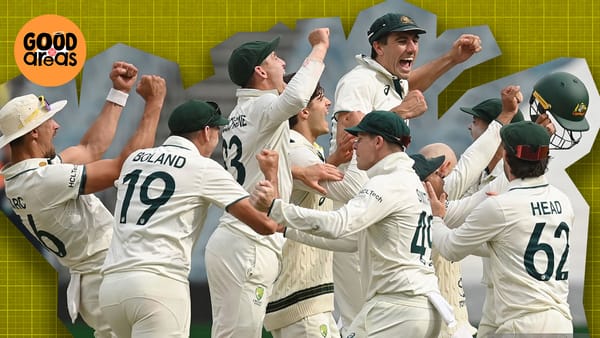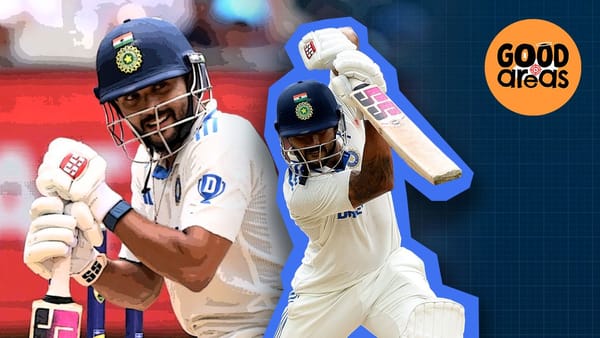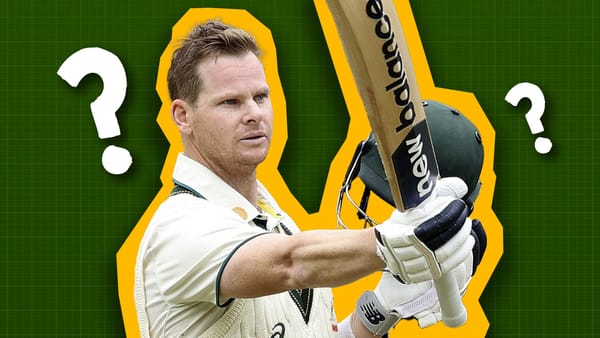New Zealand's bad WTC cycle
From first to sixth. How the best team fell this bad.
New Zealand defeated India in the final of the inaugural edition of the World Test Championship. Two years later, they finished sixth. That’s a drop. Even if you thought they were a bit lucky last time, and that their schedule played a part, it is hard to argue that last time they were in the top three teams, and now Kane Williamson and whatever was left of Neil Wagner had to steal a single to not lose at home to Sri Lanka.
So, what changed? The best way to look at that was what made them successful in the first cycle of the tournament.
NZ did not start particularly well in the previous cycle, either. They drew a series 1-1 in Sri Lanka and were whitewashed 3-0 in Australia. My calls for them to make the final looked shaky. But Sri Lanka is a tough matchup for the Kiwis being they have no obvious frontline spinner or even a secondary option. And it doesn’t seem to matter how good or bad they are, they always lose to Australia.
But what the Kiwis did next was pretty impressive, They whitewashed a strong Indian unit 2-0. But before anyone could even start to work out what this all meant, Covid happened.
And while many of us had bigger things to worry about, the World Test championship also had to react to what was going on. So the ICC changed the rule from most points to the percentage of points scored. This essentially made it tougher for teams playing more games because it would be tougher to maintain consistency over a larger set of matches. Meanwhile, NZ only plays 2 Test series at home. And remember, the smaller series was already seen as an advantage.
However, New Zealand still demolished West Indies and Pakistan at home. Despite their home dominance, they relied a fair bit on other results.
It took an amazing - yet freaky - series win from India down under, then the Aussies getting points docked for slow overrate at the MCG, and the cancellation of a couple of tours (NZ v Ban, Aus v SA) to guarantee a place for New Zealand in the final of the first phase.
That doesn’t mean New Zealand weren’t good. Remember they didn’t just fluke a couple of wins, they had been improving for a long time with a decade-old plan to be more relevant in cricket. Their ascension had something to do with their first-class players going on strike to become professionals, their player development set-up, the first-class pitches, and many other small things they did along the way. And they also won the playoff. But the actual final space fell to them through T Natarajan’s greatest moment, a team actually being penalised for slow over-rates and a worldwide pandemic that killed millions. That’s a fairly unlikely set of circumstances
But let’s compare the schedules. Because in the WTC, the most important thing to always look at is the schedule, which is so batshit insane because this is not a real league. In terms of difficulty, there really wasn’t much to separate between the two cycles. The home season was arguably easier for New Zealand this time around. However, the away tours were always going to be challenging.
While their performances on the road were also worse (0W-4L-3D) than that in WTC 1 (1W-4L-0D), the actual differentiator was their home performances. NZ had a 6-0 record in WTC 1, while they had a 4-2 record (2 of the wins came after they were out of contention) in WTC 2.


Kane Williamson was their most valuable batter in the WTC 2019-2021. Although he scored no runs on the road, he was incredible on home soil. And his elbow injury did not allow him to play 4 Tests vs Ban & SA in the 2022 home season.

You might notice that they had a few notable retirements, we need to understand if they made a significant impact on the team's performance as a whole. Ross Taylor was clearly not at his best in WTC 1, averaging nearly 33. He didn't perform in the next cycle either, averaging only 17.

BJ Watling averaged under 28 in their successful campaign. Compare that to Tom Blundell, who averages 43 in this cycle. While Watling and Taylor have been great servants of New Zealand cricket, neither was a star in that first World Test championship.

In fact, they arguably upgraded their batting strength with Daryl Mitchell and Devon Conway becoming first-choice batters in the playing XI. Tom Blundell also became one of the best lower middle-order batters in the world after taking the gloves post-Watling. He currently has one of the best averages of any keeper in Test cricket.


Colin de Grandhomme has been a utility player for the Kiwis in red-ball cricket. He gets you crucial wickets with the ball, slows down the pace and is a more than handy lower-order bat in the format. He only featured in three Tests this time around as compared to seven in the previous cycle due to a heel injury.
Their entire bowling unit was at its best in WTC 1. The self-proclaimed best seam bowling unit in the world started with a trio of Boult, Southee and Wagner and then added Kyle Jamieson - an extremely skilled pace bowler who could bat. Plus having someone like a CdG around as a 5th bowling option really did not allow opposition batters any breathing space in conducive conditions.

The primary reason for the decline in their performances comes down to the quality of bowling. They went from being the 2nd best bowling team at home in WTC 1 to the 6th best in WTC 2. They just didn’t bowl as well, and this isn’t just being away from home. Their bat-bowl average differential dropped from 24 to 12 - which is a significant fall.

Now, we have to talk about Trent Boult. NZC released him from his central contract in August 2022. This meant that his international career would now be "significantly reduced". But Boult still played in the second edition, and they also had Matt Henry playing more. This wasn’t a Boult issue.
The one thing worth noting is they played more in Asia, and NZ don't really rely much on spin bowling at home. However, they'll require a certain quality of spinners when they're touring Asian countries.
NZ won 1 out of 2 Tests in Sri Lanka in WTC 1. In this cycle, they did not win a single Test in 4 games vs India & Pakistan.
It is naturally tougher to tour India than Sri Lanka. The fact that they managed a non-negative result (a DRAW!!!) on their Indian tour was decent. And Pakistan created some of the flattest wickets of all time in all of their home series in this WTC, which obviously nullified the impact of spin bowling to a large extent. But watching Australia and England win, New Zealand had templates to follow, and a broken Pakistan team they could have exploited.
You look at their bowling from that series and they got surprisingly great numbers from Ish Sodhi, Bracewell held up nicely as a fifth option, and Tim Southee chipped away. They probably only needed one of Ajaz Patel, Matt Henry and Neil Wagner to complement the other three and they take a Test. But they all struggled.

The weird thing about New Zealand in this second cycle is that the team is better in some ways. Conway, Mitchell and Blundell are all performing better than the previous players. This means the loss of Taylor and Watling barely matters. Though Williamson’s elbow complicates this. Sodhi, Bracewell and Rachin Ravindra are the best spin unit they’ve had in some time. The big losses are de Grandhomme and Boult. But there are enough plusses to cover that. And Boult did play.
So what actually went wrong?
There are three key Tests that need to be spoken about. When Bangladesh beat them, they did so by scoring over 400 runs in Mount Maunganui against a bowling attack of Boult, Wagner, Jamieson and Southee. It wasn’t like some big innings from Tamim Iqbal and Shakib al Hasan, neither played. And no Bangladeshi batter made a hundred. They all just handled the all-star bowling lineup. That was a huge upset.
The second was the match against South Africa at home. Where they allowed the terrible Protea batters to score over 300 runs twice in a match. A feat the South Africans managed only on one other occasion in this cycle. The bowling attack in that match was Wagner, CDG, Jamieson, Henry and Southee. Ouch.
And then the third match, where NZ and Pakistan played out a classic end. All New Zealand needed was a wicket from the final 21 balls and their bowlers couldn’t find it.
That is three matches that in the previous cycle probably went differently. Williamson probably plays at Mount Maunganui and makes a huge hundred in the first innings ensuring they control that game, not Bangladesh. How many times would this South African batting lineup make 600 runs against this attack (I am betting it’s less than eight per cent)? And if you threw the Pakistan tail in for 21 balls you’d want to believe you get a wicket at least 50% of the time.
And that wasn’t even the only thing that happened to them. The entire world played England and had great fun going up against the giant pinata they’d become. And then New Zealand plays them, and it happens to be the Bazball England. Which was a different proposition that none of us understood back then.
That merged with the fact the balls went flat and were pretty easy to smash after the 20th over. If the balls were normal Dukes, it would have been a bowling shootout - like England versus South Africa was. That would have favoured New Zealand a lot more, and in the worst-case scenario, they lose 2-1.
It gets worse too, in those first two Tests in England they had injuries to bowlers that completely changed everything. And yet, remember New Zealand set England nearly 300 in every Test. You would expect England to fuck that up at least once, right?
So, just to have a lightning round. New Zealand somehow lost at home to a Bangladesh work experience team, they allowed the worst batting lineup in South African memory to score on them twice, they couldn’t dismiss a number 10 or 11 from Pakistan, and then they somehow managed to walk into England’s killing machine thanks to flat balls, and a man called Brendon McCullum who was one of the architects of their rise to win the last World Test Championship.
In other words, all the things that went right for them last time, all went against them on this occasion. And so they went from first, to not relevant.




